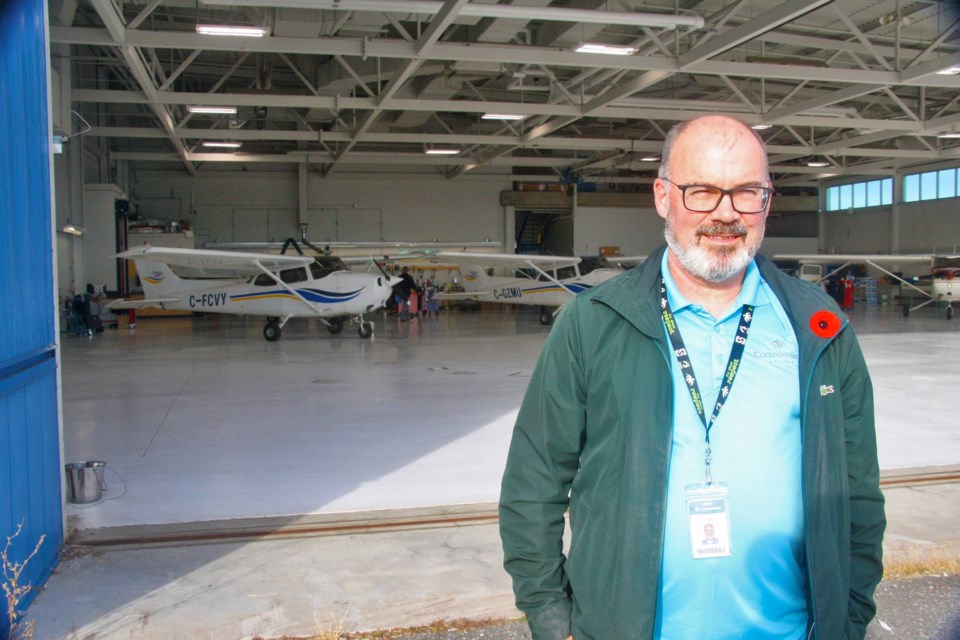The airline industry faces unprecedented changes after COVID. Shortages of both flight and maintenance crews continue to impact flights.
But in northwestern Ontario, recruiting and retaining aviation industry professionals is nothing new. The School of Aviation at Confederation College continues to help fill that need in the North with pilots, maintenance engineers, and aerospace designers and manufacturers — and help them in unique ways.
“In general, if you look at the workforce development needs for the region, colleges are probably the biggest answer to a lot of those shortfalls,” said Colin Kelly, dean of Confederation College’s School of Engineering Technology, Trades & Aviation. He added that although there are no guarantees, pretty much every student can find work after convocation if they want it.
“Anybody I’ve talked to who wants to work in their field after graduation is working.”
For Confederation College’s Flight Management program, which celebrates its 50th anniversary in 2023, capacity is a larger issue than recruitment. The program continues to have a waitlist. Each year, the program accepts 55 to 60 applicants, of which about 40 complete the program, Kelly said. Graduates leave with both their Commercial Pilot’s Licence (CPL) and a recognized Ontario College Advanced Diploma — something pilots cannot earn in private schools.
Even among the three Ontario college programs, Confederation College’s program is unique.
“The most important difference is that when you come to (Confederation), you start flying right away,” Kelly said. That can mean the first week, but almost always within three weeks. Timing is another major difference.
“It’s a three-year program that we deliver in two and a half years. You come here in September, and by May/June of the second summer, you’re ready to go. That’s attractive for students as well.”
The program’s Aviation Centre of Excellence (ACE) building is right on the tarmac at the Thunder Bay International Airport, which means that pilots can do it all from the airport — ground school, flight instruction, and dispatch — for more integrated learning.
Kelly said several improvements will help increase capacity to up to 65 new students each year including new scheduling software that will improve efficiency. The program also purchased five new Cessna 172 S aircraft and will add two new flight simulators.
Improvements within the Aviation Technician – Aircraft Maintenance program are designed to help boost applications and enrolment. As with many engineering programs, high school students often do not know about these opportunities in aviation. A credit program for high school students in Thunder Bay and the region will help increase the program’s — and the profession’s — profile.
“We have one of the largest groups of high school students we’ve had since COVID to do some of the work that relates to (Lakehead District School Board’s) High Skills Specialist Major program,” Kelly said.
Not only does it allow students to get a taste for the program, but they also get to see firsthand what studying at the ACE building is like.
“It’s nice that they can do some of that work here because we have the equipment. Of course, the hope is that once they get introduced to the program here, they will apply.”
COVID had a huge impact as well. About half in the Aircraft Maintenance program are international students, so numbers travelling to Thunder Bay dropped off tremendously. One way the college is trying to attract both Canadian and international students is to introduce a co-op program.
“Students take a mandatory co-op in between Year 1 and 2. It’s usually with a local company, but it can be anywhere across Canada,” Kelly said.
The biggest advantage is that co-op graduates can get their Aircraft Maintenance Engineering (AME) licence in almost half the time.
“Typically it would take you four years to get your licence. But if you take our program, you get credit for every month you’re in the school including co-op. You basically graduate with 21 months’ credit towards your licence.”
That makes graduates of the Confederation College program more attractive to employers because they already have hands-on experience, and because they’ll have a licensed AME in about two years instead of four.
Another change to the School of Aviation was to move the three Aerospace Manufacturing Engineering Technology programs to a new addition at the main campus in 2018. That gave the program more space while freeing up space at the ACE building for Flight Management and AME.
The Aerospace program also upgraded to state-of-the-art equipment including advanced milling machines, 3D printers, and a new Makerspace in development, which may open up to community members as well.
Many changes within the School of Aviation, including cosmetic renovations to the ACE building as well as new planes, new simulators, and new AME equipment, required help from donors and government agencies.
“That’s roughly a $5-million project that we couldn’t have done without FedNor, the Northern Ontario Heritage Fund Corporation (NOHFC), and the Thunder Bay Community Economic Development Commission,” Kelly said.
